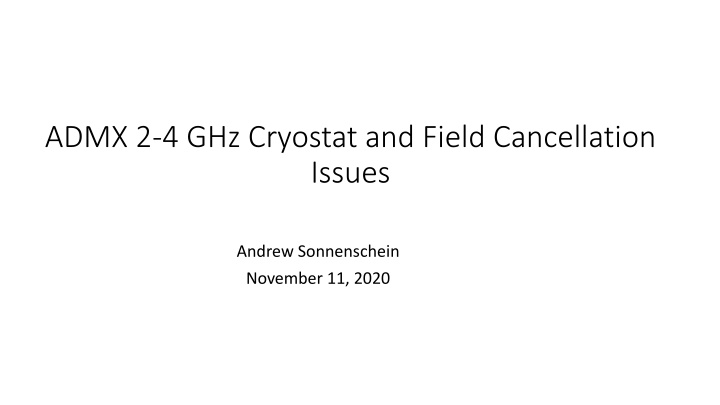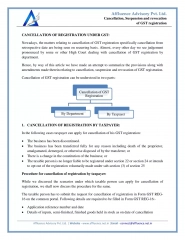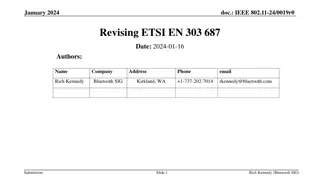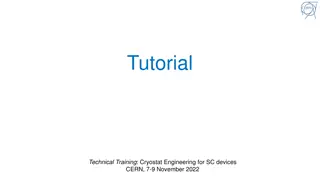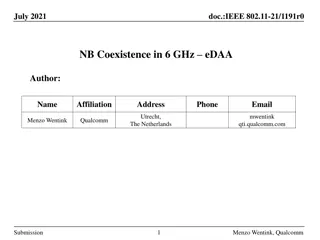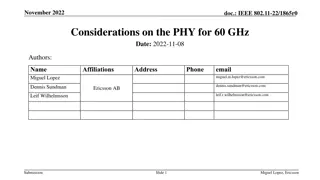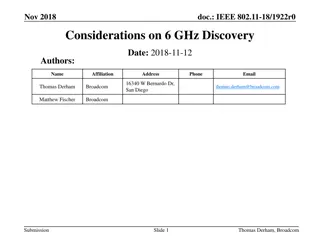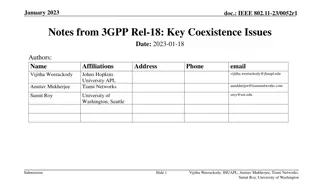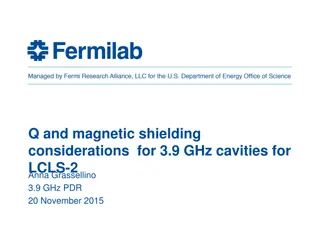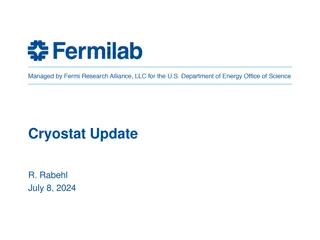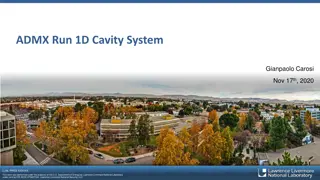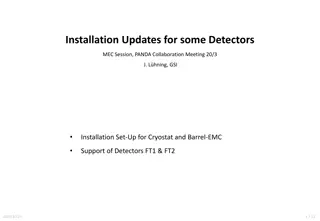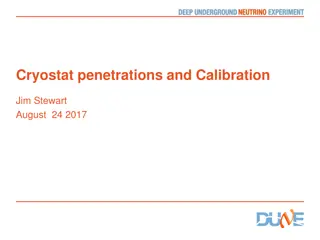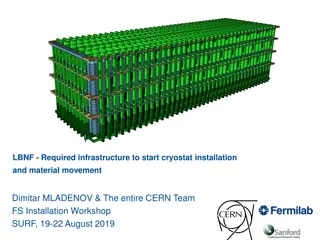ADMX 2-4 GHz Cryostat and Field Cancellation Issues
In this study by Andrew Sonnenschein, field cancellation issues related to ADMX's 2-4 GHz cryostat are explored. Various options, such as utilizing a UIC Magnet with external cancellation, are discussed. The existing magnet's field compensation performance and the technical specifications of the 9.4 T MRI magnet are detailed. Other aspects like the resonator assembly, cold electronics package, and existing magnet enclosure are also highlighted.
Download Presentation

Please find below an Image/Link to download the presentation.
The content on the website is provided AS IS for your information and personal use only. It may not be sold, licensed, or shared on other websites without obtaining consent from the author.If you encounter any issues during the download, it is possible that the publisher has removed the file from their server.
You are allowed to download the files provided on this website for personal or commercial use, subject to the condition that they are used lawfully. All files are the property of their respective owners.
The content on the website is provided AS IS for your information and personal use only. It may not be sold, licensed, or shared on other websites without obtaining consent from the author.
E N D
Presentation Transcript
ADMX 2-4 GHz Cryostat and Field Cancellation Issues Andrew Sonnenschein November 11, 2020
Option #2: UIC Magnet + External Cancellation Magnet UIC Magnet + External Cancellation Surplus magnet from University of Illinois, Chicago. 9.4 Tesla MRI with 800 mm warm bore. Manufactured by GE Healthcare/ Magnex in 2003. We would need to provide field cancellation in a new magnet with a separate cryostat. Magnet was inspected in October by Fermilab engineers Cristian Boffo and Vladimir Kashikhin- in excellent condition. 2
Field Compensated Region- Existing Magnet Field compensation below 100 Gauss over a cylindrical volume 153 mm OD x 170 mm length. Below 20 gauss over 135 mm length. Axial field profile 90000 Uncompensated 80000 Compensated 70000 60000 Field (Gauss) 50000 40000 30000 20000 10000 0 0 50 100 150 200 250 300 -10000 Distance from 8T magnet center (cm) 153 mm ID 3
9.4 T MRI Magnet 800 mm warm bore 3250 mm length Cavity refrigerator may be mounted off axis to improve access for resonator insertion. straps support Access Panel Electronics @20 mK Bucking Coil Magnet Cryostat 600 mm warm bore Electronics Dilution Refrigerator Cavity Dilution Refrigerator
Top View Cavity Dilution Refrigerator 9.4 T MRI Magnet 800 mm warm bore 3250 mm length Resonator assembly inserts through this flange Electronics @20 mK Electronics Dilution Refrigerator Bucking Coil in 600 mm warm bore cryostat Removable panels for electronics hook ups
Parameter Value Resonator Assembly Magnetic field >9 Tesla Diameter 686 mm Length 1203 mm Weight 650 kg Initial Temperature 100 mK Operating Heat Load 500 W 100 mK Specifications 1 K 10 mW 4 K 1 W 40 K 50 W Cold Electronics Package Magnetic Field <100 Gauss Diameter 450 mm Length 250 mm Weight 20 kg Temperature 20 mK Operating Heat Load 10 W 20 mK 200 W 100 mK 1 K 10 mW 4 K 1 W 40 K 50 W Distance Resonator to Electronics 2000 mm
Existing Magnet Enclosure at UIC 12 meters
Shielded Room with Steel Walls Electronics cryostat <100 G MRI Magnet Cavity Assembly Area 800 mm NbTi coax 250 mm Cu coax 4 m 4 m 3 m
Passive Magnetic Shielding Advantages Simple since no new magnet required. Low risk. Avoids issue of interactions between magnets, quenches, etc. No issue of balancing main magnet and bucking coil. Almost unlimited space for cold electronics. Better quality shielding. Cold electronics will be very accessible for maintenance. Cold electronics and cavity system can run separately. Probably no more expensive than buying a new bucking coil ( 1-2 M$?) Disadvantages Attenuation in coax lines between resonators and electronics will reduce signal to noise ratio. Adding 4- meters of 0.141 inch diameter copper cable is a 0.49 dB insertion loss- an 11% reduction in signal power. Would add about 60 mK to effective noise temperature.
Superconducting Cables Copper Semirigid Coax 0.085 0.3 dB/m insertion loss at 4 GHz Copper Semirigid Coax 0.141 0.17 dB/m @ 4 GHz Superconducting NbTi 0.085 0.007 dB @4 GHz This is 0.2% power loss per meter. Kurpiers, Walter, Magnard, Salathe and Walraff, EPJ Quantum Technology (2017) 4:8
Axial and Transverse Magnetic Field Components Axial B Field B- Field [Tesla] Magnet bore Transverse B field at 100 mm radius Distance From Magnet Center [m]
Summary/ Additional Comments Reuse of 9.4 Tesla MRI magnet appears to be best solution for ADMX 2- 4 GHz experiment at the moment. What would we need to do to establish confidence in this option? We need convince ourselves of practicality of working with horizontal magnet. Matt Hollister and Don Mitchell will work on horizontal cryostat conceptual design over next few months. Conclude negotiations with UIC, DOE and FNAL on transfer of magnet ownership. Magnetic field cancellation scheme: active or passive? In either case, we need enough engineering to show that we have a complete solution to the problem. Passive solution requires testing NbTi coax cable attenuation in magnetic field. Non superconducting solution might already be good enough (+ 60 mK noise temp?)
9.4 T MRI Magnet 800 mm warm bore 3250 mm length Electronics @20 mK
Shielded Room with Steel Walls Thicker steel wall Shielding Pipe Electronics cryostat <100 G MRI Magnet Cavity Assembly Area 800 mm NbTi coax 250 mm Cu coax As short as possible 4 m 3 m
Option #3: New 9.4 T x 800 mm Magnet with Integrated Field Cancellation Option: Purchase New 9-Tesla Magnet Tesla Engineering UK proposes a 280 mm diameter x 700 mm field cancelled region (downscaled in diameter from our proposal for 500 mm diameter x 250 mm but preserves electronics volume) New magnet could be purchased with 2-year lead time. Budgetary quotes from three vendors range from $4.2- 5.5M. Vertical orientation simplified cryogenic system Would allow integration of field cancellation in same cryostat as main magnet and reduction of the distance between high and low field region. Could function as an outsert for next phase HTS coils, eventually reaching field of >30 Tesla in a smaller bore. 18
